Can Boron and Cobalt Nanoparticles Be Beneficial Effectors to Prevent Flooding-Induced Damage in Durum and Bread Wheat at Germination and Tillering Stage?
Abstract
1. Introduction
2. Results
3. Discussion
- By Factor A. Flooding
- By Factor B. Nanoparticles
4. Materials and Methods
4.1. Production and Characterization of Nanoparticles
4.2. Plant Material
4.3. Seed Treatment
4.4. Methodology of Two-Factor Experiments
4.5. Determination of Flooding Resistance at the Germination Stage
4.6. Determination of Flood Resistance at the Tillering Stage
4.7. Morphometric Characteristics of Wheat Plants
4.8. Hyperspectral Analysis
4.9. Biochemical Analysis
4.10. Statistical Analysis
5. Conclusions
Supplementary Materials
Author Contributions
Funding
Data Availability Statement
Conflicts of Interest
References
- Sabella, E.; Aprile, A.; Negro, C.; Nicolì, F.; Nutricati, E.; Vergine, M.; Luvisi, A.; De Bellis, L. Impact of climate change on durum wheat yield. Agronomy 2020, 10, 793. [Google Scholar] [CrossRef]
- Rezaei, E.E.; Webber, H.; Asseng, S.; Boote, K.; Durand, J.L.; Ewert, F.; Martre, P.; MacCarthy, D.S. Climate change impacts on crop yields. Nat. Rev. Earth Environ. 2023, 4, 831–846. [Google Scholar] [CrossRef]
- Ramesh Chand, R.C. Challenges to ensuring food security through wheat. CABI Rev. 2009, 4, 1–13. [Google Scholar] [CrossRef]
- Ghobadi, M.E.; Ghobadi, M.; Zebarjadi, A. The response of winter wheat to flooding. World Acad. Sci. Eng. Technol. 2011, 78, 440–442. [Google Scholar]
- Mastrangelo, A.M.; Cattivelli, L. What makes bread and durum wheat different? Trends Plant Sci. 2021, 26, 677–684. [Google Scholar] [CrossRef]
- Gomez, A.; Naraya, M.; Zhao, L.; Jia, X.; Bernal, R.A.; Lopez-Moreno, M.L.; Peralta-Videa, J.R. Effects of nano-enabled agricultural strategies on food quality: Current knowledge and future research needs. J. Hazard. Mater. 2021, 401, 123385. [Google Scholar] [CrossRef]
- Feng, K.; Wang, X.; Zhou, Q.; Dai, T.; Cao, W.; Jiang, D.; Cai, J. Waterlogging priming enhances hypoxia stress tolerance of wheat offspring plants by regulating root phenotypic and physiological adaption. Plants 2022, 11, 1969. [Google Scholar] [CrossRef]
- Pais, I.P.; Moreira, R.; Semedo, J.N.; Ramalho, J.C.; Lidon, F.C.; Coutinho, J.; Macas, B.; Scotti-Campos, P. Wheat crop under waterlogging: Potential soil and plant effects. Plants 2022, 12, 149. [Google Scholar] [CrossRef]
- Kaur, G.; Singh, G.; Motavalli, P.P.; Nelson, K.A.; Orlowski, J.M.; Golden, B.R. Impacts and management strategies for crop production in waterlogged or flooded soils: A review. Agron. J. 2020, 112, 1475–1501. [Google Scholar] [CrossRef]
- Abbas, A.; Amjath-Babu, T.S.; Kächele, H.; Usman, M.; Amjed Iqbal, M.; Arshad, M.; Adnan Shahid, M.; Müller, K. Sustainable survival under climatic extremes: Linking flood risk mitigation and coping with flood damages in rural Pakistan. Environ. Sci. Pollut. Res. 2018, 25, 32491–32505. [Google Scholar] [CrossRef]
- Toulotte, J.M.; Pantazopoulou, C.K.; Sanclemente, M.A.; Voesenek, L.A.; Sasidharan, R. Water stress resilient cereal crops: Lessons from wild relatives. J. Integr. Plant Biol. 2022, 64, 412–430. [Google Scholar] [PubMed]
- León, J.; Castillo, M.C.; Gayubas, B. The hypoxia–reoxygenation stress in plants. J. Exp. Bot. 2021, 72, 5841–5856. [Google Scholar]
- Rajput, V.D.; Minkina, T.; Kumari, A.; Harish; Singh, V.K.; Verma, K.K.; Mandzhieva, S.; Sushkova, S.; Srivastava, S.; Keswani, C. Coping with the challenges of abiotic stress in plants: New dimensions in the field application of nanoparticles. Plants 2021, 10, 1221. [Google Scholar] [CrossRef] [PubMed]
- Zulfiqar, F.; Ashraf, M. Nanoparticles potentially mediate salt stress tolerance in plants. Plant Physiol. Biochem. 2021, 160, 257–268. [Google Scholar]
- Zhou, P.; Adeel, M.; Shakoor, N.; Guo, M.; Hao, Y.; Azeem, I.; Li, M.; Liu, M.; Rui, Y. Application of nanoparticles alleviates heavy metals stress and promotes plant growth: An overview. Nanomaterials 2020, 11, 26. [Google Scholar] [CrossRef]
- Roco, M.C. Nanotechnology: Convergence with modern biology and medicine. Curr. Opin. Biotech. 2003, 14, 337–346. [Google Scholar]
- Nel, A.; Xia, T.; Madler, L.; Li, N. Toxic potential of materials at the nanolevel. Science 2006, 311, 622–627. [Google Scholar]
- Modena, M.M.; Rühle, B.; Burg, T.P.; Wuttke, S. Nanoparticle characterization: What to measure? Adv. Mater. 2019, 31, 1901556. [Google Scholar]
- Saini, S.; Kumar, P.; Sharma, N.C.; Sharma, N.; Balachandar, D. Nano-enabled Zn fertilization against conventional Zn ana-logues in strawberry (Fragaria × ananassa Duch.). Sci. Hortic. 2021, 282, 110016. [Google Scholar]
- Meier, S.; Moore, F.; Morales, A.; González, M.E.; Seguel, A.; Meriño-Gergichevich, C.; Rubilar, O.; Cumming, J.; Aponte, H.; Alarcon, D.; et al. Synthesis of calcium borate nanoparticles and its use as a potential foliar fertilizer in lettuce (Lactuca sativa) and zucchini (Cucurbita pepo). Plant Physiol. Biochem. 2020, 151, 673–680. [Google Scholar]
- Chen, H. Metal based nanoparticles in agricultural system: Behavior, transport, and interaction with plants. Chem. Spec. Bioavail. 2018, 30, 123–134. [Google Scholar] [CrossRef]
- Hu, X.; Wei, X.; Ling, J.; Chen, J. Cobalt: An essential micronutrient for plant growth? Front. Plant Sci. 2021, 12, 768523. [Google Scholar] [CrossRef] [PubMed]
- Rai, P.K.; Kumar, V.; Lee, S.; Raza, N.; Kim, K.H.; Ok, Y.S.; Tsang, D.C. Nanoparticle-plant interaction: Implications in energy, environment, and agriculture. Environ. Inter. 2018, 119, 1–19. [Google Scholar] [CrossRef] [PubMed]
- Mahmoud, A.W.M.; Abdeldaym, E.A.; Abdelaziz, S.M.; El-Sawy, M.B.; Mottaleb, S.A. Synergetic effects of zinc, boron, silicon, and zeolite nanoparticles on confer tolerance in potato plants subjected to salinity. Agronomy 2019, 10, 19. [Google Scholar] [CrossRef]
- Sutulienė, R.; Brazaitytė, A.; Małek, S.; Jasik, M.; Samuolienė, G. Response of oxidative stress and antioxidant system in pea plants exposed to drought and boron nanoparticles. Antioxidants 2023, 12, 528. [Google Scholar] [CrossRef]
- Leipunsky, I.O.; Zhigach, A.N.; Kuskov, M.L.; Berezkina, N.G.; Afanasenkova, E.S.; Kudrov, B.V.; Lopez, G.W.; Vorobjeva, G.A.; Naumkin, A.V. Synthesis of TiH2 nano powder via the guen-miller flow-levitation method and characterization. J. Alloys Comp. 2019, 778, 271–279. [Google Scholar] [CrossRef]
- Mehra, V.; Kumar, S.; Tamang, A.M.; Chandraker, S.K. Green synthesis of gold nanoparticles (AuNPs) by using plant extract and their biological application: A review. BioNanoScience 2025, 15, 18. [Google Scholar] [CrossRef]
- Pansambal, S.; Oza, R.; Borgave, S.; Chauhan, A.; Bardapurkar, P.; Vyas, S.; Ghotekar, S. Bioengineered cerium oxide (CeO2) nanoparticles and their diverse applications: A review. Appl. Nanosci. 2023, 13, 6067–6092. [Google Scholar] [CrossRef]
- Vijayaram, S.; Razafindralambo, H.; Sun, Y.Z.; Vasantharaj, S.; Ghafarifarsani, H.; Hoseinifar, S.H.; Raeeszadeh, M. Applications of green synthesized metal nanoparticles—A review. Biol. Trace Elem. Res. 2024, 202, 360–386. [Google Scholar] [CrossRef]
- Beliaev, D.V.; Tereshonok, D.V.; Lunkova, N.F.; Baranova, E.N.; Osipova, E.S.; Lisovskii, S.V.; Raldugina, G.N.; Kuznetsov, V.V. Expression of cytochrome c3 from Desulfovibrio vulgaris in plant leaves enhances uranium uptake and tolerance of tobacco. Int. J. Mol. Sci. 2021, 22, 12622. [Google Scholar] [CrossRef]
- Sanjana, S.; Jazeel, K.; Janeeshma, E.; Nair, S.G.; Shackira, A.M. Synergistic interactions of assorted ameliorating agents to enhance the potential of heavy metal phytoremediation. Stress Biol. 2024, 4, 13. [Google Scholar] [CrossRef] [PubMed]
- Kulathunga, J.; Reuhs, B.L.; Zwinger, S.; Simsek, S. Comparative study on kernel quality and chemical composition of ancient and modern wheat species: Einkorn, emmer, spelt and hard red spring wheat. Foods 2021, 10, 761. [Google Scholar] [CrossRef] [PubMed]
- Aniskina, T.S.; Baranova, E.N.; Lebedev, S.V.; Reger, N.S.; Besaliev, I.N.; Panfilov, A.A.; Kryuchkova, V.A.; Gulevich, A.A. Unexpected effects of sulfate and sodium chloride application on yield qualitative characteristics and symmetry indicators of hard and soft wheat kernels. Plants 2023, 12, 980. [Google Scholar] [CrossRef] [PubMed]
- López-Luna, J.; Nopal-Hormiga, Y.; López-Sánchez, L.; Mtz-Enriquez, A.I.; Pariona, N. Effect of methods application of copper nanoparticles in the growth of avocado plants. Sci. Total Environ. 2023, 880, 163341. [Google Scholar]
- Perea Velez, Y.S.; Carrillo-González, R.; Gonzalez-Chavez, M.D.C.A. Interaction of metal nanoparticles–plants–microorganisms in agriculture and soil remediation. J. Nanoparticle Res. 2021, 23, 206. [Google Scholar] [CrossRef]
- Churilov, D.G.; Polishchuk, S.D.; Shemyakin, A.V.; Churilova, V.V.; Ivanycheva, Y.N. Dose-dependent biological effects in iron, copper, and cobalt nanoparticles on vetch and spring wheat plants. Nanobiotechnol. Rep. 2023, 18, 419–428. [Google Scholar]
- Akhtar, N.; Ilyas, N.; Arshad, M.; Meraj, T.A.; Hefft, D.I.; Jan, B.L.; Ahmad, P. The impact of calcium, potassium, and boron application on the growth and yield characteristics of durum wheat under drought conditions. Agronomy 2022, 12, 1917. [Google Scholar] [CrossRef]
- Brdar-Jokanović, M. Boron toxicity and deficiency in agricultural plants. Int. J. Mol. Sci. 2020, 21, 1424. [Google Scholar] [CrossRef]
- Perea-Vélez, Y.S.; Carrillo-González, R.; González-Chávez, M.D.C.A.; Vangronsveld, J.; Monasterio, I.O.; Maruri, D.T. Citrate-coated cobalt ferrite nanoparticles for the nano-enabled biofortification of wheat. Food Funct. 2023, 14, 4017–4035. [Google Scholar]
- Ueno, K.; Takahashi, H. Varietal variation and physiological basis for inhibition of wheat seed germination after excessive water treatment. Euphytica 1997, 94, 169–173. [Google Scholar]
- Hadidi, M.; Ghobadi, M.; Saeidi, M.; Ghobadi, M.E. Grain yield, its components and some physiologic characteristics of flag leaf in commercial wheat cultivars in response to post-anthesis drought stress. Cereal Biotechnol. Biochem. 2023, 2, 153–169. [Google Scholar]
- Akbarzade Sharafi, A.; Jalali Honarmand, S.; Chaghazardi, H.R.; Ghobadi, M.I. Effect of foliar application of plant-derived smoke-water on growth and grain yield of bread wheat (Triticum aestivum L.) cultivars under rained conditions. Iran. J. Crop Sci. 2024, 26, 19–34. [Google Scholar]
- Todorova, D.; Aleksandrov, V.; Anev, S.; Sergiev, I. Photosynthesis alterations in wheat plants induced by herbicide, soil drought or flooding. Agronomy 2022, 12, 390. [Google Scholar] [CrossRef]
- Todorova, D.; Aleksandrov, V.; Anev, S.; Sergiev, I. Comparative study of photosynthesis performance of herbicide-treated Young triticale plants during drought and waterlogging stress. Agronomy 2023, 13, 1992. [Google Scholar] [CrossRef]
- Shahkoomahali, H.; Galeshi, S.; Soltani, A.; Zeinali, E. Investigating the effects of flooding stress in different developmental stages on the content of antioxidant enzymes, photosynthetic pigments and grain yield of wheat. J. Crop Prod. 2021, 14, fa1–fa16. [Google Scholar]
- Burgos, S.; Stamp, P.; Schmid, J.E. Agronomic and physiological study of cold and flooding tolerance of spelt (Triticum spelta L.) and wheat (Triticum aestivum L.). J. Agron. Crop Sci. 2001, 187, 195–202. [Google Scholar]
- Maksimović, M.; Omanović-Mikličanin, E. Towards green nanotechnology: Maximizing benefits and minimizing harm. In CMBEBIH 2017: Proceedings of the International Conference on Medical and Biological Engineering; Springer: Singapore, 2017; pp. 164–170. [Google Scholar]
- Srivastava, N. Interaction of cobalt nanoparticles with plants: A cytogenetical aspect. J. Exp. Nanosci. 2015, 10, 769–776. [Google Scholar]
- Noaema, A.H.; Alhasany, A.R. Effect of spraying nano fertilizers of potassium and boron on growth and yield of wheat (Triticum aestivum L.). IOP Conf. Ser. Mater. Sci. Eng. 2020, 871, 012012. [Google Scholar]
- Riaz, M.; Kamran, M.; Rizwan, M.; Ali, S.; Wang, X. Foliar application of silica sol alleviates boron toxicity in rice (Oryza sativa) seedlings. J. Hazard. Mater. 2022, 423, 127175. [Google Scholar]
- Davydova, N.V.; Zamana, S.P.; Krokhmal, I.I.; Ryezepkin, A.M.; Romanova, E.S.; Olkhovskaya, I.P.; Bogoslovskaya, O.A.; Yablokov, A.G.; Glushchenko, N.N. Spring wheat features in response to seed treatment by metal nanoparticles. Nanotech. Russ. 2019, 14, 572–581. [Google Scholar]
- Yurina, T.A.; Drobin, G.V.; Bogoslovskaya, O.A.; Olkhovskaya, I.P.; Glushchenko, N.N. Plant growth stimulants. Biol. Agricult. 2020, 56, 135–145. [Google Scholar]
- Baranova, E.N.; Shelepova, O.V.; Zolotukhina, A.A.; Nesterov, G.V.; Sudarikov, K.A.; Latushkin, V.V.; Gulevich, A.A. Application of optical methods to assess physiological damage to wheat flag leaves. Photonics Russ. 2024, 18, 320–330. [Google Scholar]
- Aniskina, T.S.; Sudarikov, K.A.; Levinskikh, M.A.; Gulevich, A.A.; Baranova, E.N. Bread wheat in space flight: Is there a dif-ference in kernel quality? Plants 2023, 13, 73. [Google Scholar] [CrossRef] [PubMed]
- Huang, S.; Tang, L.; Hupy, J.P.; Wang, Y.; Shao, G. A commentary review on the use of normalized difference vegetation index (NDVI) in the era of popular remote sensing. J. For. Res. 2021, 32, 1–6. [Google Scholar]
- Lichtenthaler, H.K.; Buschmann, C. Chlorophylls and Carotenoids: Measurement and Characterization by UV-VIS Spectroscopy. Curr. Protoc. Food Anal. Chem. 2001, 1, F4.3.1–F4.3.8. [Google Scholar]
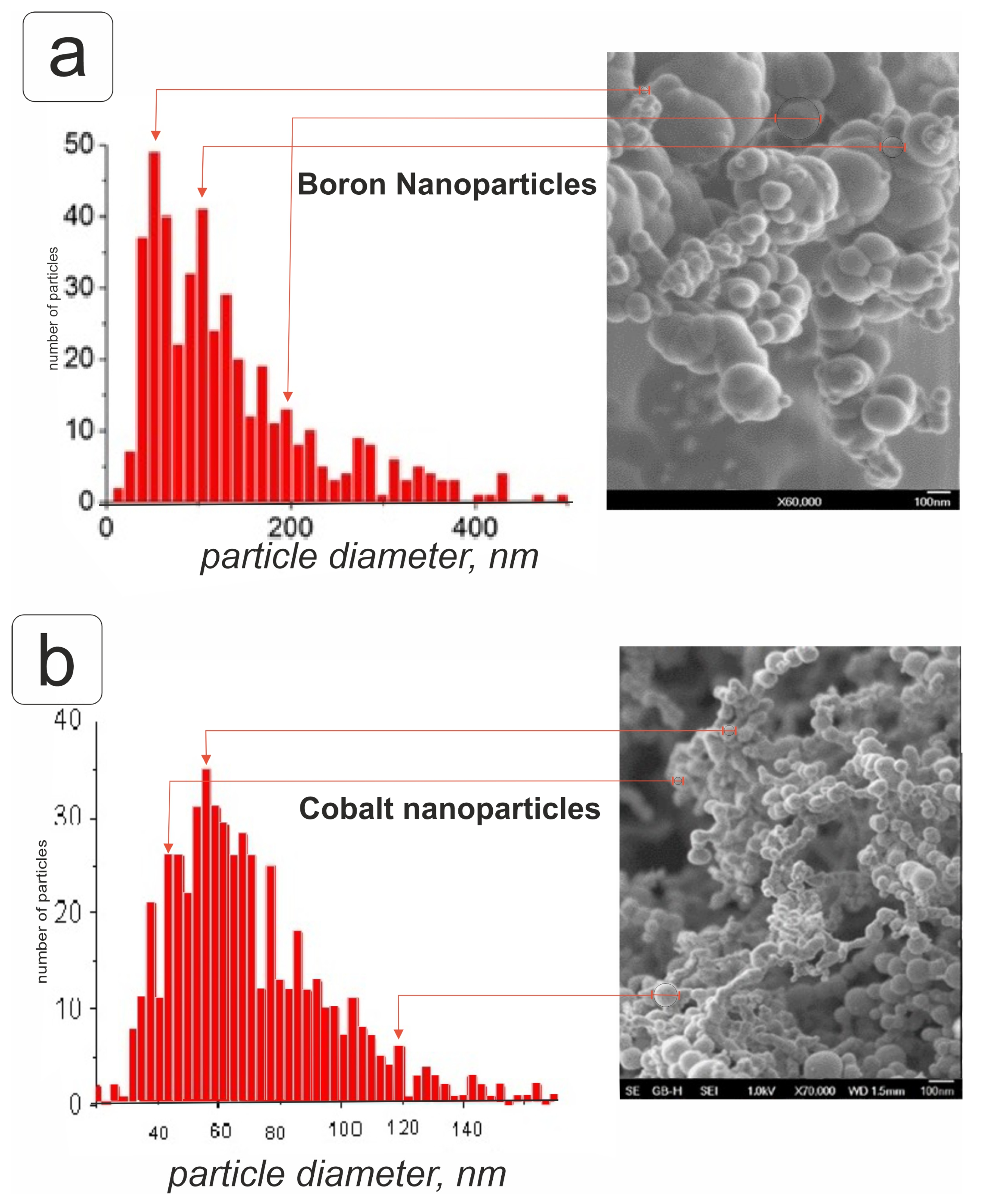

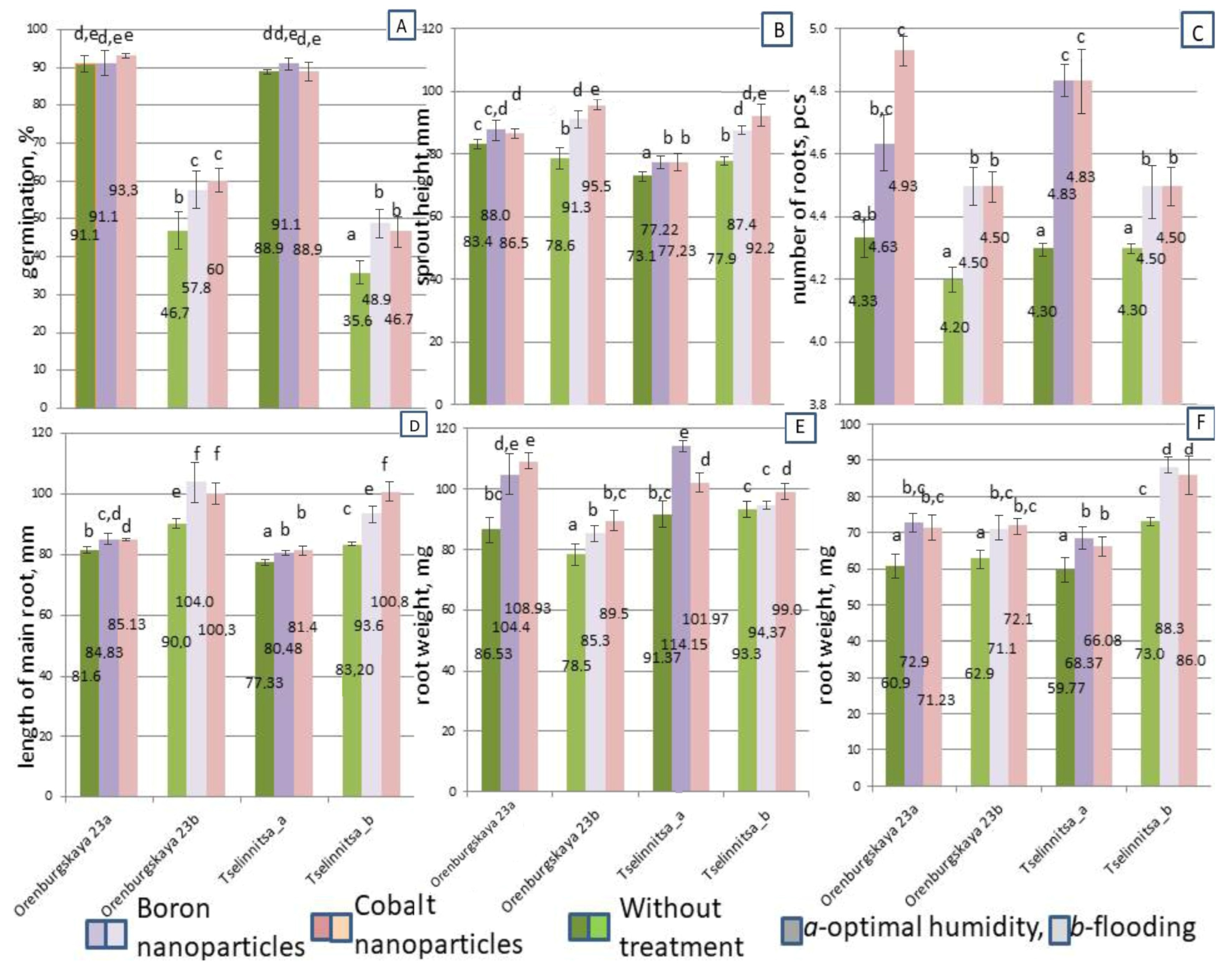

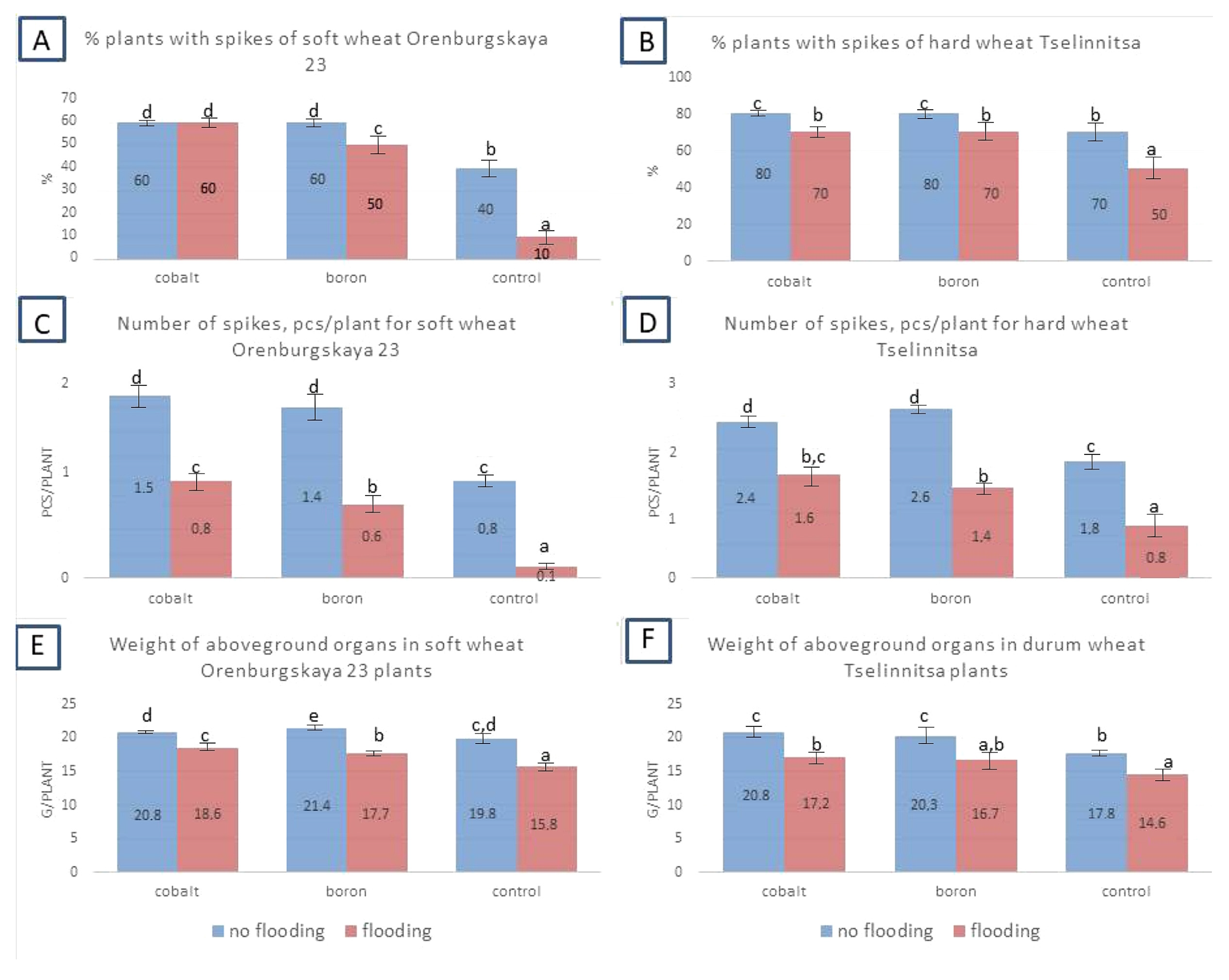
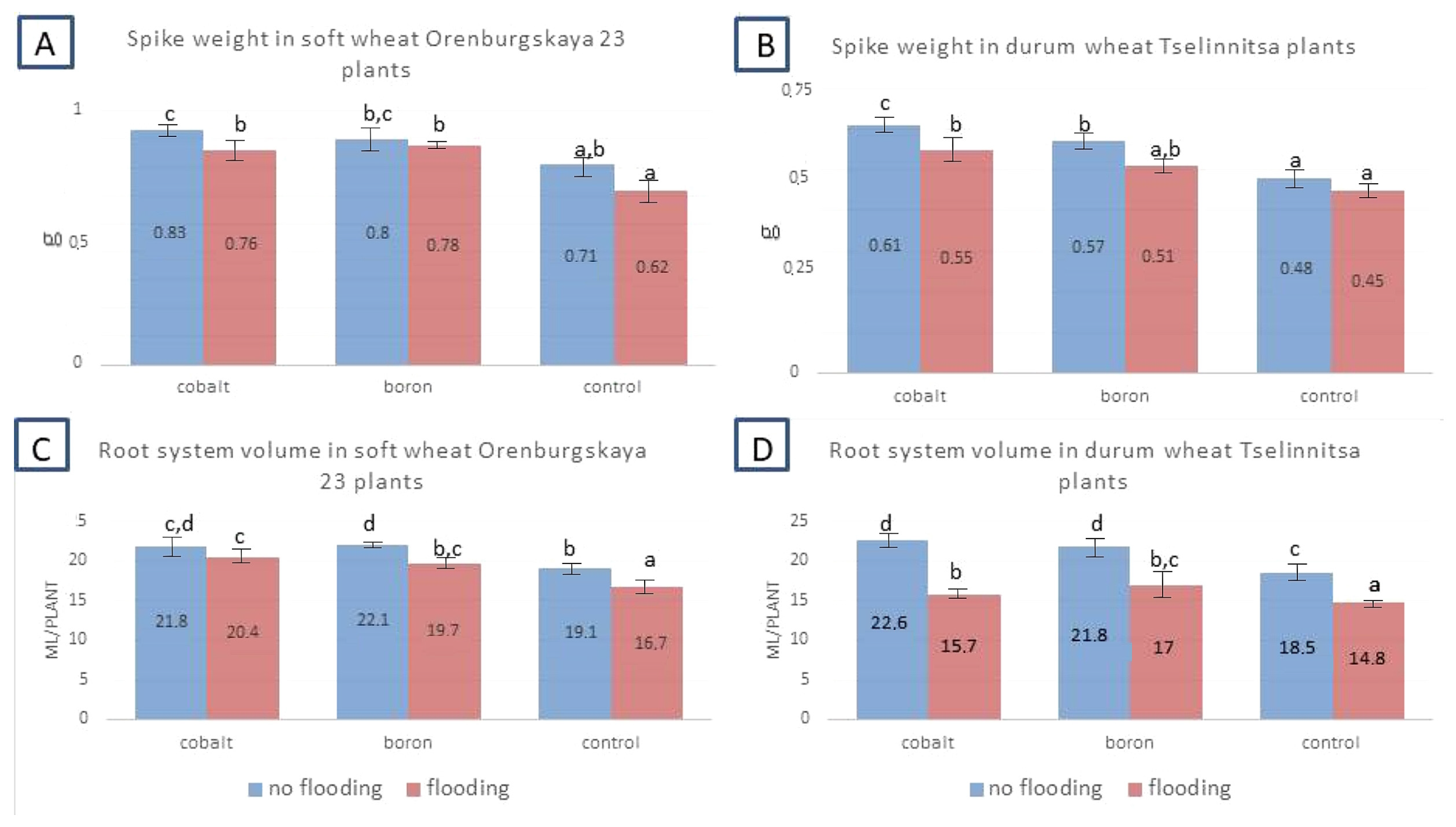
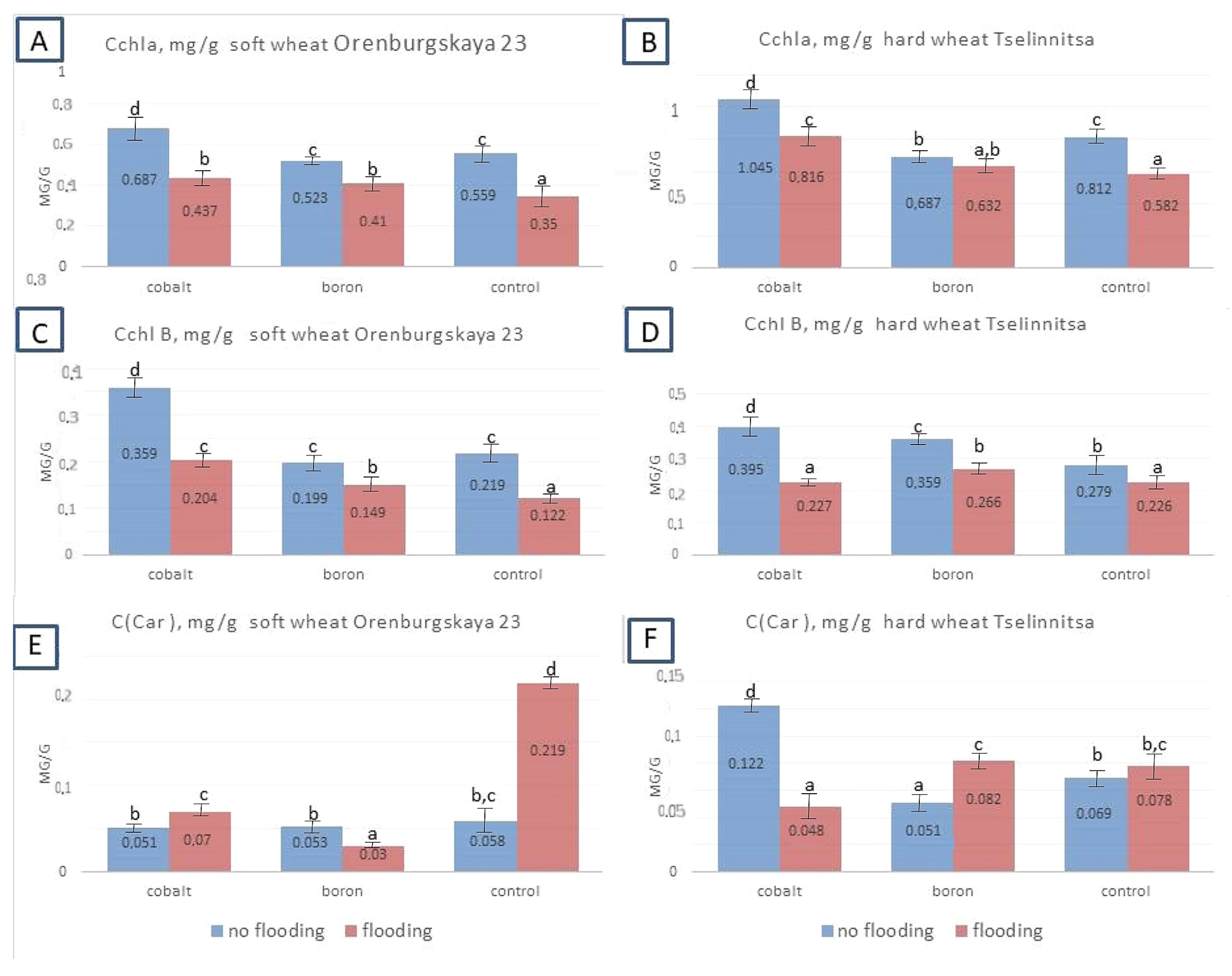

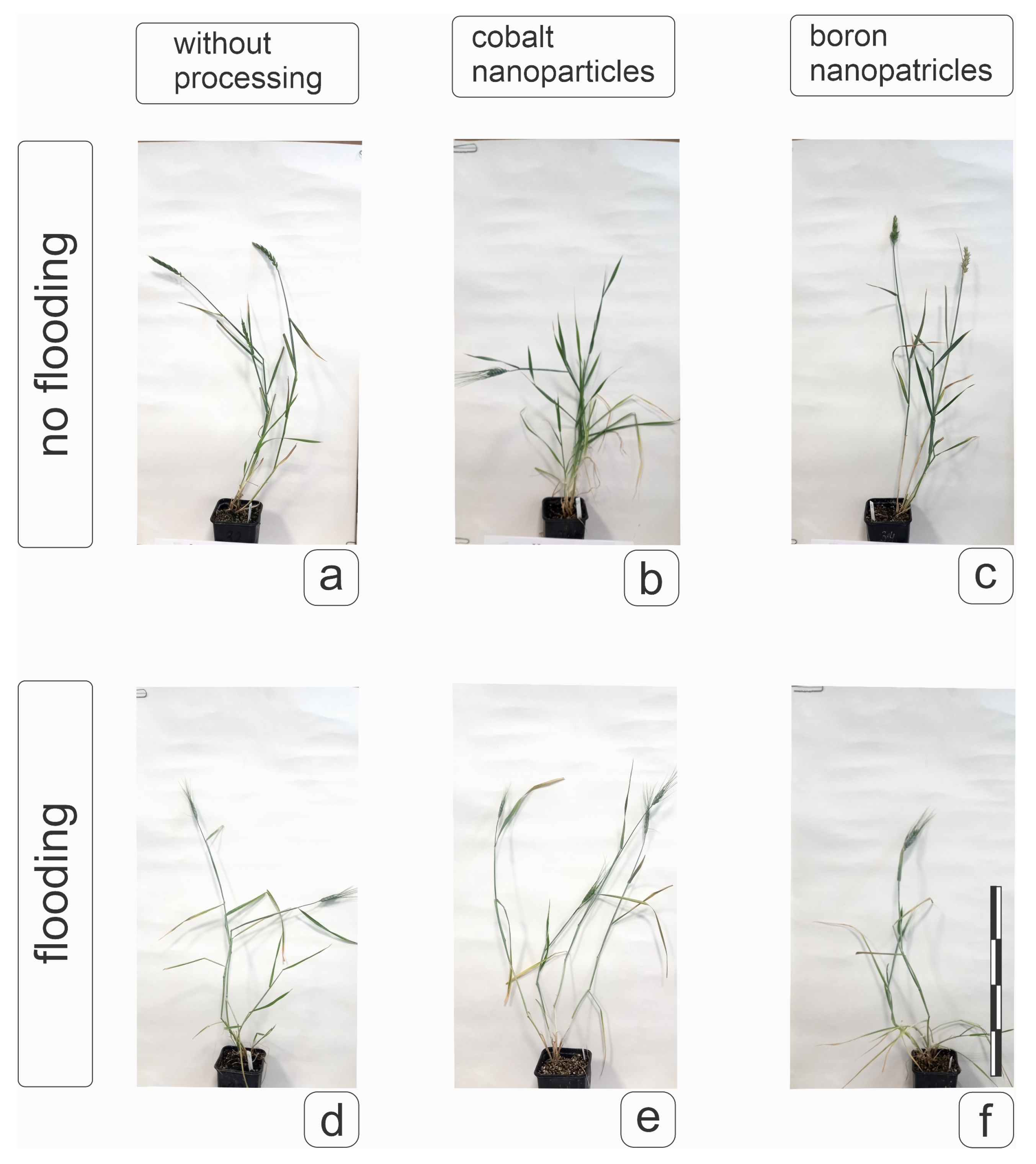
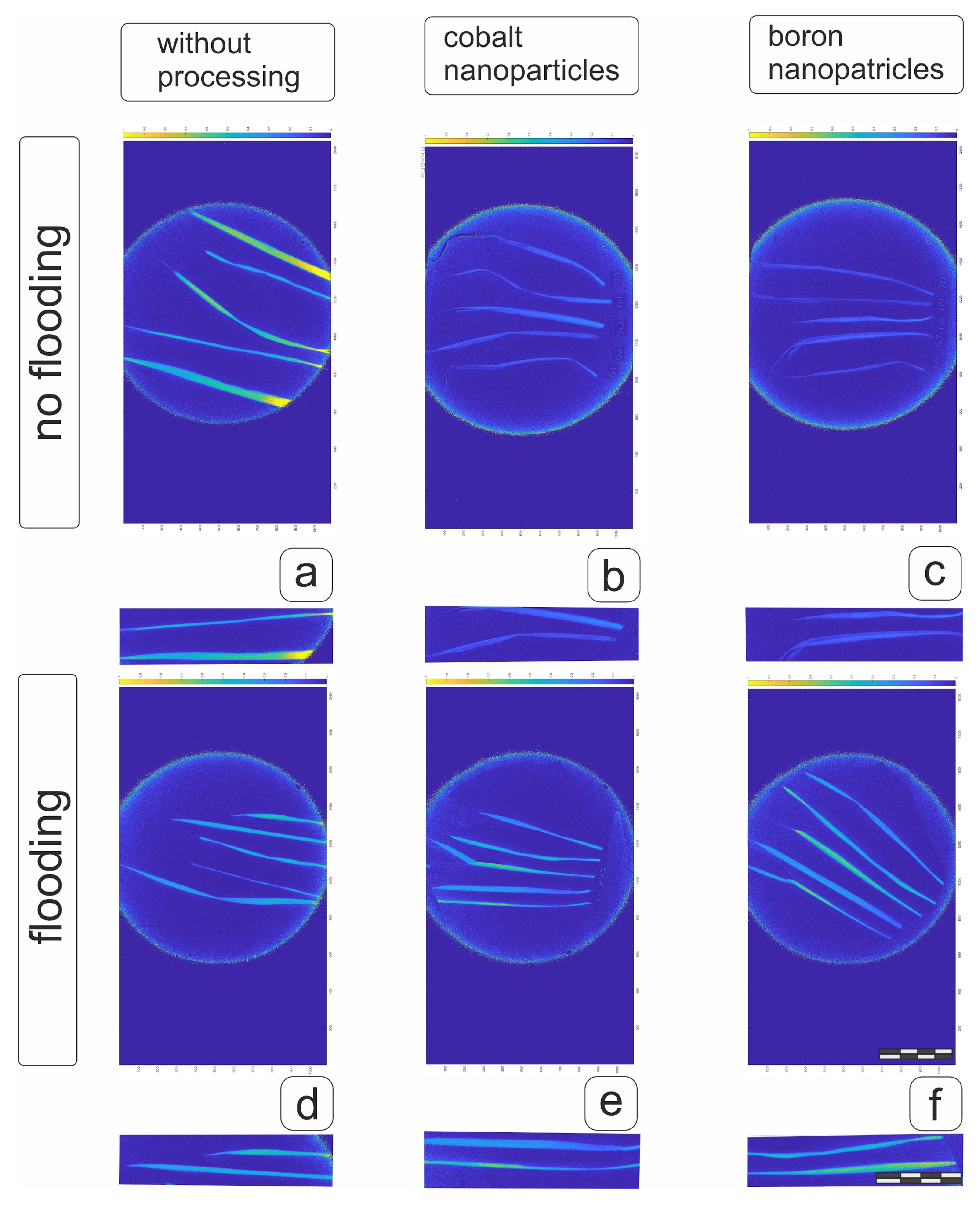

Disclaimer/Publisher’s Note: The statements, opinions and data contained in all publications are solely those of the individual author(s) and contributor(s) and not of MDPI and/or the editor(s). MDPI and/or the editor(s) disclaim responsibility for any injury to people or property resulting from any ideas, methods, instructions or products referred to in the content. |
© 2025 by the authors. Licensee MDPI, Basel, Switzerland. This article is an open access article distributed under the terms and conditions of the Creative Commons Attribution (CC BY) license (https://creativecommons.org/licenses/by/4.0/).
Share and Cite
Novikova, A.A.; Podlasova, E.Y.; Lebedev, S.V.; Latushkin, V.V.; Glushchenko, N.N.; Sudarikov, K.A.; Gulevich, A.A.; Vernik, P.A.; Shelepova, O.V.; Baranova, E.N. Can Boron and Cobalt Nanoparticles Be Beneficial Effectors to Prevent Flooding-Induced Damage in Durum and Bread Wheat at Germination and Tillering Stage? Plants 2025, 14, 1044. https://doi.org/10.3390/plants14071044
Novikova AA, Podlasova EY, Lebedev SV, Latushkin VV, Glushchenko NN, Sudarikov KA, Gulevich AA, Vernik PA, Shelepova OV, Baranova EN. Can Boron and Cobalt Nanoparticles Be Beneficial Effectors to Prevent Flooding-Induced Damage in Durum and Bread Wheat at Germination and Tillering Stage? Plants. 2025; 14(7):1044. https://doi.org/10.3390/plants14071044
Chicago/Turabian StyleNovikova, Antonina A., Ekaterina Y. Podlasova, Svyatoslav V. Lebedev, Vyacheslav V. Latushkin, Natalia N. Glushchenko, Kirill A. Sudarikov, Alexander A. Gulevich, Pyotr A. Vernik, Olga V. Shelepova, and Ekaterina N. Baranova. 2025. "Can Boron and Cobalt Nanoparticles Be Beneficial Effectors to Prevent Flooding-Induced Damage in Durum and Bread Wheat at Germination and Tillering Stage?" Plants 14, no. 7: 1044. https://doi.org/10.3390/plants14071044
APA StyleNovikova, A. A., Podlasova, E. Y., Lebedev, S. V., Latushkin, V. V., Glushchenko, N. N., Sudarikov, K. A., Gulevich, A. A., Vernik, P. A., Shelepova, O. V., & Baranova, E. N. (2025). Can Boron and Cobalt Nanoparticles Be Beneficial Effectors to Prevent Flooding-Induced Damage in Durum and Bread Wheat at Germination and Tillering Stage? Plants, 14(7), 1044. https://doi.org/10.3390/plants14071044







